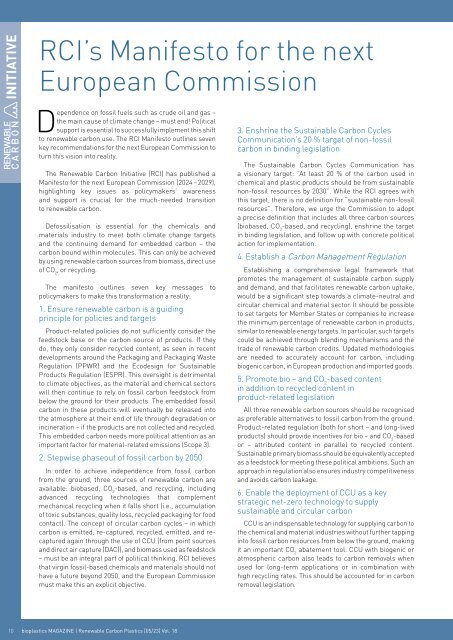Issue 05/2023
Highlights Fibres / Textiles Polyurethane / Elastomers
Highlights
Fibres / Textiles
Polyurethane / Elastomers
You also want an ePaper? Increase the reach of your titles
YUMPU automatically turns print PDFs into web optimized ePapers that Google loves.
INITIATIVE<br />
RCI’s Manifesto for the next<br />
European Commission<br />
RENEWABLE<br />
CARBON<br />
Dependence on fossil fuels such as crude oil and gas –<br />
the main cause of climate change – must end! Political<br />
support is essential to successfully implement this shift<br />
to renewable carbon use. The RCI Manifesto outlines seven<br />
key recommendations for the next European Commission to<br />
turn this vision into reality.<br />
The Renewable Carbon Initiative (RCI) has published a<br />
Manifesto for the next European Commission (2024 – 2029),<br />
highlighting key issues as policymakers’ awareness<br />
and support is crucial for the much-needed transition<br />
to renewable carbon.<br />
Defossilisation is essential for the chemicals and<br />
materials industry to meet both climate change targets<br />
and the continuing demand for embedded carbon – the<br />
carbon bound within molecules. This can only be achieved<br />
by using renewable carbon sources from biomass, direct use<br />
of CO 2<br />
, or recycling.<br />
The manifesto outlines seven key messages to<br />
policymakers to make this transformation a reality:<br />
1. Ensure renewable carbon is a guiding<br />
principle for policies and targets<br />
Product-related policies do not sufficiently consider the<br />
feedstock base or the carbon source of products. If they<br />
do, they only consider recycled content, as seen in recent<br />
developments around the Packaging and Packaging Waste<br />
Regulation (PPWR) and the Ecodesign for Sustainable<br />
Products Regulation (ESPR). This oversight is detrimental<br />
to climate objectives, as the material and chemical sectors<br />
will then continue to rely on fossil carbon feedstock from<br />
below the ground for their products. The embedded fossil<br />
carbon in these products will eventually be released into<br />
the atmosphere at their end of life through degradation or<br />
incineration – if the products are not collected and recycled.<br />
This embedded carbon needs more political attention as an<br />
important factor for material-related emissions (Scope 3).<br />
2. Stepwise phaseout of fossil carbon by 2<strong>05</strong>0<br />
In order to achieve independence from fossil carbon<br />
from the ground, three sources of renewable carbon are<br />
available: biobased, CO 2<br />
-based, and recycling, including<br />
advanced recycling technologies that complement<br />
mechanical recycling when it falls short (i.e., accumulation<br />
of toxic substances, quality loss, recycled packaging for food<br />
contact). The concept of circular carbon cycles – in which<br />
carbon is emitted, re-captured, recycled, emitted, and recaptured<br />
again through the use of CCU (from point sources<br />
and direct air capture (DAC)), and biomass used as feedstock<br />
– must be an integral part of political thinking. RCI believes<br />
that virgin fossil-based chemicals and materials should not<br />
have a future beyond 2<strong>05</strong>0, and the European Commission<br />
must make this an explicit objective.<br />
3. Enshrine the Sustainable Carbon Cycles<br />
Communication’s 20 % target of non-fossil<br />
carbon in binding legislation<br />
The Sustainable Carbon Cycles Communication has<br />
a visionary target: “At least 20 % of the carbon used in<br />
chemical and plastic products should be from sustainable<br />
non-fossil resources by 2030”. While the RCI agrees with<br />
this target, there is no definition for “sustainable non-fossil<br />
resources”. Therefore, we urge the Commission to adopt<br />
a precise definition that includes all three carbon sources<br />
(biobased, CO 2<br />
-based, and recycling), enshrine the target<br />
in binding legislation, and follow up with concrete political<br />
action for implementation.<br />
4. Establish a Carbon Management Regulation<br />
Establishing a comprehensive legal framework that<br />
promotes the management of sustainable carbon supply<br />
and demand, and that facilitates renewable carbon uptake,<br />
would be a significant step towards a climate-neutral and<br />
circular chemical and material sector. It should be possible<br />
to set targets for Member States or companies to increase<br />
the minimum percentage of renewable carbon in products,<br />
similar to renewable energy targets. In particular, such targets<br />
could be achieved through blending mechanisms and the<br />
trade of renewable carbon credits. Updated methodologies<br />
are needed to accurately account for carbon, including<br />
biogenic carbon, in European production and imported goods.<br />
5. Promote bio – and CO 2<br />
-based content<br />
in addition to recycled content in<br />
product-related legislation<br />
All three renewable carbon sources should be recognised<br />
as preferable alternatives to fossil carbon from the ground.<br />
Product-related regulation (both for short – and long-lived<br />
products) should provide incentives for bio – and CO 2<br />
-based<br />
or – attributed content in parallel to recycled content.<br />
Sustainable primary biomass should be equivalently accepted<br />
as a feedstock for meeting these political ambitions. Such an<br />
approach in regulation also ensures industry competitiveness<br />
and avoids carbon leakage.<br />
6. Enable the deployment of CCU as a key<br />
strategic net-zero technology to supply<br />
sustainable and circular carbon<br />
CCU is an indispensable technology for supplying carbon to<br />
the chemical and material industries without further tapping<br />
into fossil carbon resources from below the ground, making<br />
it an important CO 2<br />
abatement tool. CCU with biogenic or<br />
atmospheric carbon also leads to carbon removals when<br />
used for long-term applications or in combination with<br />
high recycling rates. This should be accounted for in carbon<br />
removal legislation.<br />
10<br />
bioplastics MAGAZINE | Renewable Carbon Plastics [<strong>05</strong>/23] Vol. 18

















